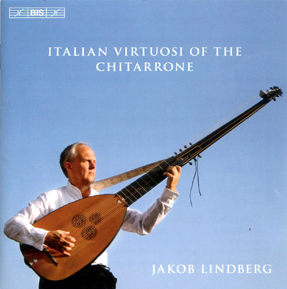I could have started this recommendation praising the musicianship of Jakob Lindberg,
who is a long established and illustrious master in this repertoire.
But it doesn't matter where I begin extolling the virtues of this wonderful disc.
The result is seventy-five minutes of completely absorbing listening.
Hbdirect Sept 2012
Lovely sound…as fine an example as you can wish for…a modern virtuoso who knows the repertoire…beautifully recorded too.
BBC radio 3 CD review , Feb. 2013
Klangkultur ist das Schlüsselwort von Lindbergs interpretation…seine Gestaltung der musikalischen Phrasen, die immer gesanglich bleiben
Musik , Klang
, Klang 
Fono Forum, Nov. 2012
Tekniskt skickligare, mer genomtänkt och trovärdigare kan man knappast föreställa sig.
Hifi & Musik , Oct 2012
Jakob Lindberg macht seinem Ruf als excellenten Lautenisten alle Ehre – auch auf der Chitarrone ist sein Spiel von berückender Schönheit
Interpretation: , Klangqualität
, Klangqualität 
Klassik, Oct 2012
In einer breiten Palette von Musik und durchhaus individuellen Persönlichkeiten demonstriert Lindberg die Vielfalt der Sololiteratur, die innerhalb der ersten Blütezeit der Chitarrone entstanden ist. Dabei erhält Lindberg reichlich Gelegenheit, einerseits seine staunenswerte Virtuosität auf dem schwierigen Instrument in Spiel zu bringen, auf der anderen Seite aber auch stimmungsvolle Momente zu gestalten.
Künstlerische Qualität 9 (max 10), Klangqualität 9 (max 10)
Klassik heute, Sept 2012
Hbdirect Sept 2012
Lovely sound…as fine an example as you can wish for…a modern virtuoso who knows the repertoire…beautifully recorded too.
BBC radio 3 CD review , Feb. 2013
Klangkultur ist das Schlüsselwort von Lindbergs interpretation…seine Gestaltung der musikalischen Phrasen, die immer gesanglich bleiben
Musik
Fono Forum, Nov. 2012
Tekniskt skickligare, mer genomtänkt och trovärdigare kan man knappast föreställa sig.
Hifi & Musik , Oct 2012
Jakob Lindberg macht seinem Ruf als excellenten Lautenisten alle Ehre – auch auf der Chitarrone ist sein Spiel von berückender Schönheit
Interpretation:
Klassik, Oct 2012
In einer breiten Palette von Musik und durchhaus individuellen Persönlichkeiten demonstriert Lindberg die Vielfalt der Sololiteratur, die innerhalb der ersten Blütezeit der Chitarrone entstanden ist. Dabei erhält Lindberg reichlich Gelegenheit, einerseits seine staunenswerte Virtuosität auf dem schwierigen Instrument in Spiel zu bringen, auf der anderen Seite aber auch stimmungsvolle Momente zu gestalten.
Künstlerische Qualität 9 (max 10), Klangqualität 9 (max 10)
Klassik heute, Sept 2012
